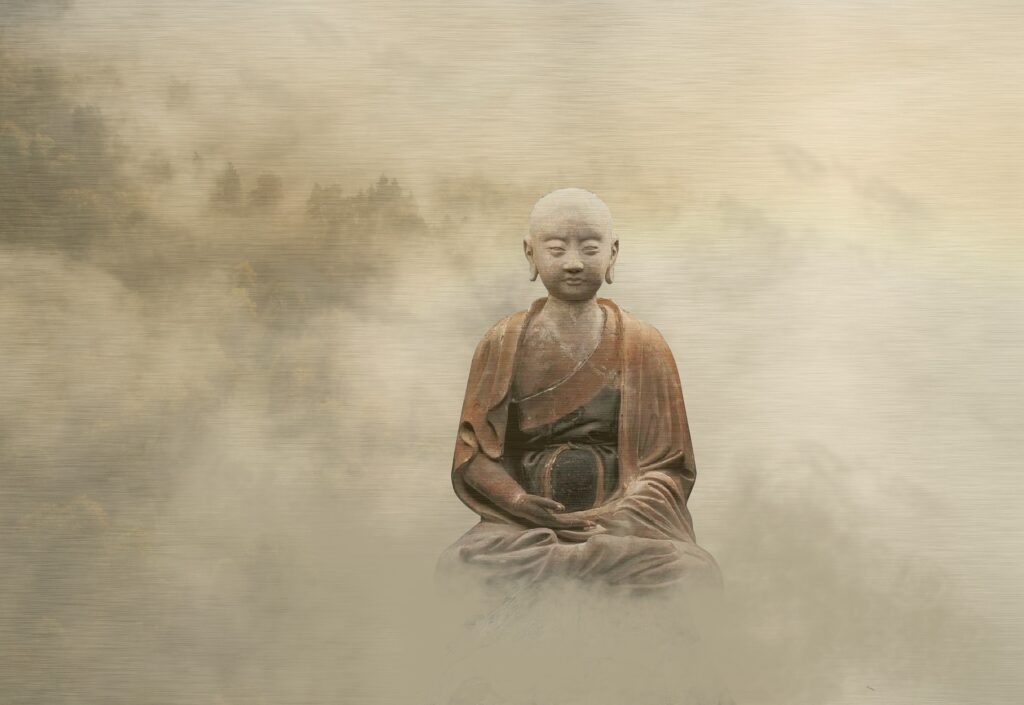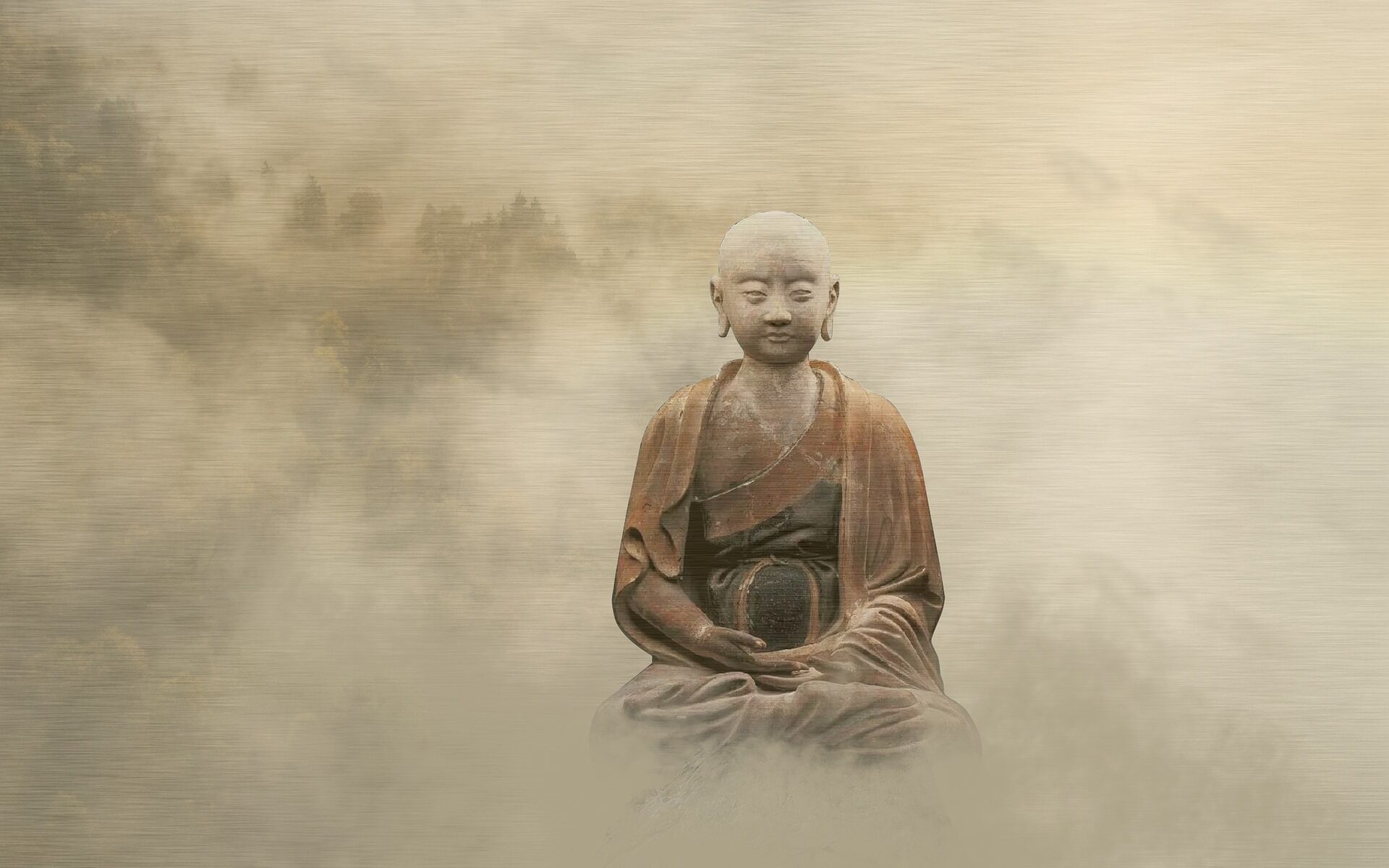
The Mindfulness of Breathing is a calming meditation where we focus on our breathing to help find respite from mental restlessness, and gently train our “monkey mind”. I learned this technique and practise it regularly at our local Buddhist Centre, and I hope you find this post about it useful.
Disclaimer
As with most things on the internet, it comes with a disclaimer: I wouldn’t recommend this if you’re suffering from an acute mental health crisis. That’s a bit like having a broken leg (i.e. a serious acute condition) and discovering a blog post on running and keeping fit (i.e. a post about general wellbeing). If you’re experiencing a crisis, please reach out to someone, perhaps The Samaritans (telephone 116 123 in the UK) who are lovely, or chat to your GP.
This disclaimer actually comes from personal experience. Whereas meditation is an indispensable part of my life, I found it utterly awful and best avoided while I was struggling with an acute depressive episode some years back. Once I was back in the general swing of work, life, bills, socialising and dealing with the common-or-garden life stuff, meditation practice really came into its own for me.
The stages
The Meditation is broken up into four stages:
- Counting on the outbreath
- Counting on the inbreath
- Watch the breath as it comes and goes, in and out…
- Focus on the point of entry of the breath into the body
While meditating in the Buddhist Centre, the person leading the meditation will mark each stage with a bell or a tap on a meditation bowl, and if there are any beginners or anyone new to this meditation, they will talk us through the stages. If I’m meditating alone, I will use the Insight Timer meditation app.
Sit comfortably
I sit on a couple of cushions, as I found myself nodding off in a chair. Some people try to go for the crossed-legs posture, or the full lotus (!), palms upwards on the knees, making an ‘o’ between a finger and thumb. I never do this, and haven’t done it in the 15 years I’ve been meditating, simply because it’s uncomfortable.
If meditation is uncomfortable, then (a) it’s less likely to be a “good” meditation and (b) you’re more likely to find excuses to not do it, or give up after six weeks or something. Monks and householders in India, Sri Lanka and other areas had been sitting on floors, cross-legged like that since they were children, but here in the UK most of us were plonked on stools and little chairs from a very young age and developed a different posture.
So I kneel on a mat, sitting on a couple of round cushions to give me a bit of height.
It can get cold meditating, so I’ll wrap a blanket round my waist and tuck my hands into a bit just beneath my navel, this helps prevent strain on my shoulders.
I’ll then sit awhile, wiggling a bit until I feel properly “supported”. Sometimes an image of stacked Jenga blocks will come to mind, or a Weeble, or I’ll mentally picture a thread from the base of my spine reaching through the top of my head and disappearing into the sky. This is just to help posture: I’m not “channeling energies” or anything. I just want to sit up straight to minimise backache.
What I’m aiming for is a kind of posture and attention a bit like that of a cat sitting in the middle of a room:

And from here I’ll let my eyes gently half-close, and just breathe
Just breathe
For a bit, I’ll just breathe and allow by breath to settle down into a natural rhythm.
Mindfulness of the outbreath
I’ll start by mentally counting on the outbreath.
Breathe in, breathe out, count “one”. Breathe in, breathe out, count “two”. Breathe in, breathe out, count “three”… And so on up to “ten”. And then back to breathe in, breathe out, count “one”, breathe in, breathe out, count “two”…
If my mind wanders, and it will, I bring my breath back to the counting, starting with “one” again. Now, here’s an important part of the practice: do so gently and kindly. This is very important, as one of the life-lessons of the Mindfulness of Breathing I’ve found most important is to be kind to myself if I fall off a wagon, and just get back on again without self-recrimination. I’ll write about this in more depth later, but for now, just remember to “be kind” if you lose count or start thinking about your shopping list or having a mental row with your partner or whatever, and start again from “one”.
Mindfulness of the inbreath
Count “one”, breathe in, breathe out… Count “two”, breathe in, breathe out… And so on up to “ten”, and then start again. The count should go right before you breathe in: you may find there’s a little gap between finishing breathing out and starting to breathe in again, so you count just before you start breathing in.
Again, you may find yourself having discursive thoughts about DIY, the latest episode of the Mandalorian, imaginary political arguments with the writer of an opinion column you read over breakfast. If this happens, again, just gently and kindly bring your attention back to breathing and counting. You can always attend to these things later, this is your time, your space and little mindfulness oasis from all of that stuff.
I may hear traffic outside or be disturbed by noise. At our Buddhist Centre, we sometimes get football fans walking past on the way to a Norwich FC game. It sounds like they’re having fun, I have no idea what they’re chanting but I just let them do their thing, I’m doing mine. Roadworks, drills and lorries beeping? Killer pumping bass out of a neighbour’s Fiesta? It’s just life, I just let it do its thing.
I’d only interrupt a meditation if I or someone else is in peril, or there’s a genuine physical need. Other than that the world can get on without my attention for half an hour. It goes without saying that you should really go for a pee before starting meditation, but sometimes you get caught short, in which case mindfully stop, quietly and discreetly leave, pee, and just as quietly, mindfully and discreetly sneak back in again and pick up where you left off.
Coughs, sneezes and itches? If you need to cough, cough. Ditto sneezes, scratches, adjustments to posture, stretching a dead leg… Just bring yourself back to the mindfulness of breathing meditation.
Just watching the breath
For the third stage, we just leave the counting behind, and just pay attention to the breath as a whole, as it comes in and out. What does it feel like? Is it cool or warm? Where’s it coming from? Where’s it going?
Sometimes I experience a kind of synaesthesia. Breath comes in, it is a silvery-grey slope on a mountainside. Breathe goes out, and it’s a downward slope on the other side. Or maybe I experience tubes or lights moving. If I notice this I bring my attention back to the breathing: it’s not a sign of enlightenment, it’s a sign I’m nodding off. The same goes for any images: I’ll bring my focus back to breathing.
Often though I just experience a kind of stillness and clarity. Sometimes my monkey-mind will still find things to distract me with, but by this stage it’s usually a quiet emptiness. Which is nice. It’s not nibbana, or enlightenment, but a very restorative space to be in. Is this “mindfulness”?
Focussing on a point
The last stage we focus on a single point where our breath enters our body. For me it’s usually the very tip of my nose. If I use any point inside my nose, I’ll often sneeze.
I find this stage very restorative. Someone in my class once mentioned “the sky-like mind”. Experiencing my mind free of thoughts was quite interesting, and this metaphor seemed very apt. It felt like a sky, and thoughts felt like little distant clouds. More prosaically: if I’m not my thoughts, what am I? What is it that experiences thoughts?
Ending the meditation
At the end, I’ll sit awhile abiding in a peaceful state, gradually checking in on my body and surroundings. Maybe a stretch. I’ll stand up slowly, and perhaps have some tea.
Links and resources
I don’t receive any payment, bribes or anything to put these links here! I just thought they may be handy.
The Insight Timer site and app have a guided meditation by Bodhipaksa that I use: https://insighttimer.com/bodhipaksa/guided-meditations/mindfulness-of-breathing-in-four-stages
If I don’t use Bodhipaksa’s guided meditation, I have some bells set up on timers in the app that ring for each stage.
The Buddhist Centre Website has a more concise description of the Mindfulness of Breathing here: https://thebuddhistcentre.com/text/mindfulness-breathing

